Ross Palmer Beecher (born 1957) is a contemporary mixed media artist who creates "quilts, flags, portraits of famous film directors and American folk heroes, and other types of objects from aluminum cans and found objects". [1] She lives and works in Seattle.
Ross Palmer Beecher | |
|---|---|
| Born | 1957 Greenwich, Connecticut |
| Nationality | American |
| Education | Rhode Island School of Design |
| Known for | Art from found objects, especially discarded metals |
Ross Palmer Beecher was born in Greenwich, Connecticut, in 1957. [4] [5] She studied painting, printmaking, and illustration at the Rhode Island School of Design in Providence. [6] She left school after two years to move to Seattle, where she took odd jobs, "deli work, parking cars, and working in a laundromat". [5] In 1999, Matthew Kangas outlined Beecher's personal and artistic development over the 17-year period after she left the Rhode Island School of Design. After multiple odd jobs, she began creating metal-and-mixed-media wall sculptures from materials she found while riding her bicycle in Seattle: "gas caps, bottle caps, auto tail light fragments, and empty soft drink cans". [5] In the mid 1980s, "folk art-inspired exhibitions in Texas, Illinois, Louisiana, and California" invited her participation. [5] She accepted a position in 1993 as Artist in Residence at Bailey-Boushay House for patients with HIV/AIDS. [7]
Beecher’s strict formal control and rigid symmetry are the foundational skeleton of her art. However, within the quilt grids, all hell breaks loose: spirals, sunbursts, maze shapes, diamonds and circles all have their day as our apprehension of each piece reveals license plates, paint tubes, olive oil cans, aerosol paint cans and other cast-offs.
— Matthew Kangas [8]
Beecher's art has been well-received by critics. According to Kangas, her artworks "gained regional and national attention in galleries, museums, and private and public art collections". [5]
While her art is inspired by American folk art forms such as "quilting, flag-making, bricolage, and primitive portraiture", she is not a folk artist. [9] Kangas wrote that her early art has links to the work of unlettered artists but is "quirky enough (in technique and subject) to separate her out from true Outsider or folk art". [5]
Judy Wagonfeld of the Seattle Post-Intelligencer said of her work, "Stitching scavenged fabric, wood and metal, she crafts offbeat flags and Americana rife with satire. What appears simple turns convoluted. It's as though you order a corn dog and get esoteric polenta with prosciutto". [10] According to Wagonfeld, her works pay homage to the folk art genre, while satirizing the elitist art world, and her glitzy metal quilts honor women's work as art. [10]
Reviewing a 2014 installation at Greg Kucera Gallery in Seattle, Kangas noted Beecher's art is "an utterly unique amalgam of folk art, Pop Art and engaged social-political art". [9] Kangas notes her largest works are a "nod, both droll and commemorative to Jasper Johns and Joseph Albers". [8] Kangas comments that while he wants Beecher to explode more beyond the tight quilt grids, her works have a "substantial material presence" that carries her concepts. [8]

Deborah Kay Butterfield is an American sculptor. Along with her artist-husband John Buck, she divides her time between a farm in Bozeman, Montana, and studio space in Hawaii. She is known for her sculptures of horses made from found objects, like metal, and especially pieces of wood.

Mary Henry, born Mary M. Dill, was an American artist whose work, most notably large oil paintings and acrylics but also prints, was characteristized by geometric abstraction. Many of her pieces are diptychs and some are triptychs. Some of her work resembles, variously, op art, constructivism, or even psychedelic art.
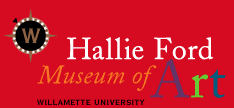
The Hallie Ford Museum of Art (HFMA) is the museum of Willamette University in Salem, Oregon, United States. It is the third largest art museum in Oregon. Opened in 1998, the facility is across the street from the Oregon State Capital in downtown Salem, on the western edge of the school campus. Hallie Ford exhibits collections of both art and historical artifacts with a focus on Oregon related pieces of art and artists in the 27,000 square feet (2,500 m2) facility. The museum also hosts various traveling exhibits in two of its six galleries.
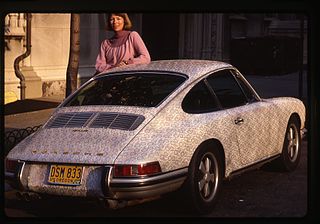
Phyllis Yes is an Oregon-based artist and playwright. Her artistic media range from works on painted canvas to furniture, clothing, and jewelry. She is known for her works that “feminize” objects usually associated with a stereotypically male domain, such as machine guns, hard hats, and hammers. Among her best-known artworks are “Paint Can with Brush,” which appears in Tools as Art, a book about the Hechinger Collection, published in 1996 and her epaulette jewelry, which applies “feminine” lace details to the epaulette, a shoulder adornment that traditionally symbolizes military prowess. In 1984 she produced her controversial and widely noted “Por She,” a silver 1967 Porsche 911-S, whose body she painstakingly painted in highly tactile pink and flesh-toned lace rosettes. She exhibited it at the Bernice Steinbaum Gallery in New York in 1984 and drove it across the United States as a traveling exhibition in 1985. In 2016, she wrote her first play, Good Morning Miss America, which began its first theatrical run at CoHo Theatre in Portland, Oregon in March 2018.
Jack Daws is a Seattle-based American artist. Working with assisted readymades, mixed media sculpture, and photography, his work addresses a range of socio-political and cultural issues.
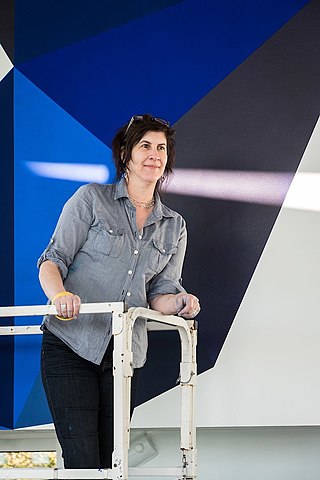
Victoria Haven is an American artist known for her investigative drawing practices which often operate in the spaces between two and three dimensions. Using materials as varied as tape, rubber-bands, Gore-Tex, forged steel, and excavated building components, her work traces the corridors of real and imagined space. Critics say her "geometric abstractions...draw connections between landscape, history, and lived experience" with her work Blue Sun echoing the "weight and volume [of] the Olympic Mountain range" of Washington State. The artist says Blue Sun was inspired by time-lapse video of demolition and reconstruction in Seattle's South Lake Union neighborhood.
Lynne Woods Turner is an American contemporary abstract painter. She holds a B.A. from Stephens College, Columbia, MO and an M.F.A. from University of Iowa, Iowa City. Stephanie Snyder, curator at the Cooley Gallery at Reed College, describes her work as having "emerge(d) through the artist's passionate exploration of mathematical relationships, natural phenomena, and the visceral responses of the human body." She shows at Greg Kucera Gallery Inc., Seattle, Danese/Corey, New York, and Gallery Joe, Philadelphia. Her work is in numerous public art collections including the MOMA Collection, the Judith Rothschild Foundation and the Fogg Art Museum, Harvard University, and the National Gallery of Art.
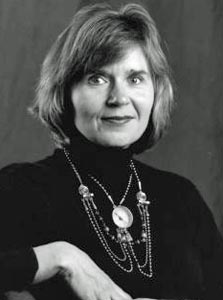
Nancy Lee Worden was an American artist and metalsmith. Her jewelry art is known for weaving together personal narratives with current politics. She received many awards and honors. Worden exhibited internationally, and her work is represented in collections around the world, including the Smithsonian American Art Museum and the Museum of Fine Arts, Boston.
Louisiana Bendolph is an American visual artist and quilt maker. Bendolph is associated with The Quilts of Gee's Bend and her work has been considered more conceptual because of her use of vibrant color.
Eunice Lulu Parsons, also known as Eunice Jensen Parsons, is an American modernist artist known for her collages. Parsons was born in Loma, Colorado, and currently lives in Portland, Oregon. She studied at the School of the Art Institute of Chicago and the Portland Museum Art School, where she also worked as a teacher for over 20 years.
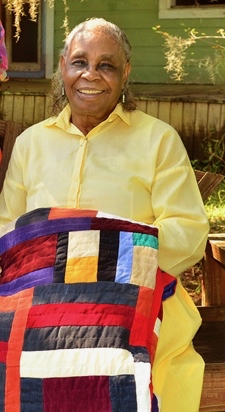
Mary Lee Bendolph is an American quilt maker of the Gee's Bend Collective from Gee's Bend (Boykin), Alabama. Her work has been influential on subsequent quilters and artists and her quilts have been exhibited in museums and galleries around the country. Bendolph uses fabric from used clothing for quilting in appreciation of the "love and spirit" with old cloth. Bendolph has spent her life in Gee's Bend and has had work featured in the Philadelphia Museum of Art as well as the Minneapolis Institute of Art in Minnesota.
Gwendolyn (Gwen) Ann Magee was an African-American fiber artist. Learning to quilt in the middle of her life, Magee quickly became known in the world of fiber art for her abstract and narrative quilts depicting the African-American experience. Her work can be found in the permanent collections of the Mississippi Museum of Art, the Museum of Mississippi History, the Michigan State University Museum, and the Renwick Gallery of the Smithsonian Museum of American Art, and has been exhibited internationally.
Cecelia Tapplette Pedescleaux, also known as Cely, is an African-American quilter of traditional and art quilts, inspired by historians, other African-American quilters, and quilt designs used during the Underground Railroad to communicate messages to slaves seeking freedom. Her quilts have been shown in China, France, Washington, D.C., New Orleans, and in other locations in the United States. A solo show of 75 of her quilts were shown at the Le Musée de Free People of Color in New Orleans (2013–2014).
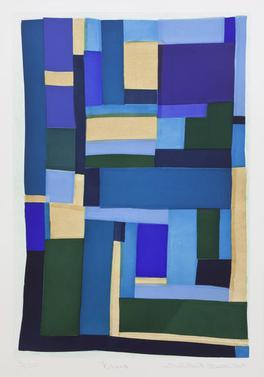
Blues is a 2007 print by Gee's Bend quilter Loretta Pettway Bennett located on the Eskenazi Health campus, near downtown Indianapolis, Indiana, and is part of the Eskenazi Health Art Collection.

Forever (For Old Lady Sally) is a 2006 print by Gee's Bend quilter Loretta Pettway Bennett located on the Eskenazi Health campus, near downtown Indianapolis, Indiana, and is part of the Eskenazi Health Art Collection.

Sew Low is a 2011–2012 quilt by Gee's Bend quilter Loretta Pettway Bennett. It is located on the Eskenazi Health campus, near downtown Indianapolis, Indiana, and is part of the Eskenazi Health Art Collection.

Vegetation is a 2009 quilt by Gee's Bend quilter Loretta Pettway Bennett. It is located on the Eskenazi Health campus, near downtown Indianapolis, Indiana, and is part of the Eskenazi Health Art Collection.
Tip Toland is an American ceramic artist and teacher who was born in Pottstown, Pennsylvania. She earned a BFA in Ceramics from the University of Colorado and an MFA in Ceramics from Montana State University. Her works, which are figurative and often described as "hyper-real," are held by galleries and museums around the United States.
Michael Charles Spafford was an American artist known for his archetypal, figurative oil paintings drawn from Classical mythology. Spafford taught painting at the University of Washington, Seattle until his retirement in 1994.

Katy Stone is an American visual artist recognized for her installation-based artworks evoking organic forms, patterns, and natural phenomena. Stone's wall-mounted or suspended sculptural constructions, often composed of layers of painted transparent film, paper, or metal, have been exhibited in museums, galleries, and public collections worldwide. Installations by Stone have been commissioned for the University of Michigan's Ross School of Business, Ann Arbor, MI; Microsoft, Redmond, WA; Facebook, Seattle, WA; Cleveland Clinic, Cleveland, OH; Swedish Medical Center, Seattle, WA; Ascent at Roebling's Bridge Covington, KY; the Federal Courthouse, Jackson Mississippi; Barnes-Jewish Hospital, St Louis, MO; Columbia University School of Nursing, New York, NY; Twin Parks, Taichung, Taiwan; and other public institutions and collections. Stone's artworks were exhibited in the U.S. Embassy in Baghdad as part of the US Art in Embassies Program.